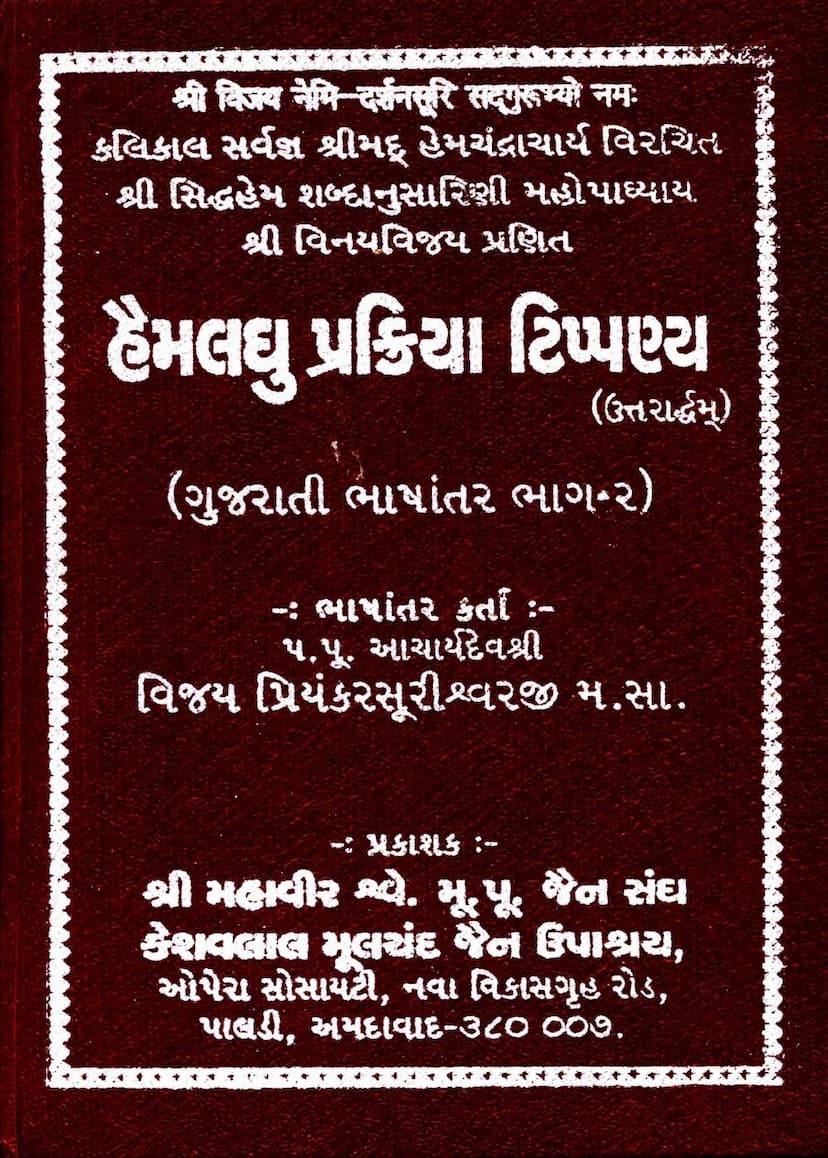Haim Laghu Prakriya Tippanya Part 02
Added to library: September 1, 2025
Loading image...

Summary
This document is the Gujarati translation of the second part (Uttarardha) of the "Shri Siddha-Haima Shabdanusarini" grammar, specifically the "Haim Laghu Prakriya Tippanya" by Acharya Vijay Priyankarsuri.
Here's a breakdown of the content:
-
Book Details:
- Title: Haim Laghu Prakriya Tippanya Part 02 (હેમલઘુ પ્રક્રીયા ટિપ્પણ્ય (ઉત્તરાદ્ધ) ગુજરાતી ભાષાંતર ભાગ ૨)
- Original Author: Acharya Hemachandracharya ( Shri Siddha-Haima Shabdanusarini)
- Commentary/Translation Author: Acharya Vijay Priyankarsuri (આચાર્યદેવશ્રી વિજય પ્રિયંકરસૂરીશ્વરજી મ.સા.)
- Publisher: Shri Mahavir Chhe. Mu. Pu. Jain Sangh, Opera Society, Ahmedabad. (શ્રી મહાવીર છે. મૂ. પૂ. જૈન સંધ કેશવલાલ મડચંદ ન ઉપાશ્રય, ઓપેચ સોસાયટી, નવા વિકાસગૃહ રોડ, 'પાલડી, અમદાવાદ-૩૮૦ ૦૭.)
- Catalog Link: Provided as jainqq.org/explore/023393/1
- Publication Details: First Edition published in Samvat 2048 (1992 CE) in Margashirsha Sud 11.
-
Content Overview:
- The book is the Gujarati translation of the commentary on the Uttarardha (second part) of the Hemachandra's grammar.
- The content primarily focuses on Sanskrit grammar, specifically the verb conjugation (Akhyat Prakriya) and its various aspects.
- The detailed explanation covers a wide range of grammatical rules and examples derived from Sanskrit verb roots (Dhatus).
- It systematically explains the formation of different verb forms based on tenses (like present, past, future), moods (like imperative, potential), voices (parasmaipada, atmanepada, ubhayapada), and specific grammatical categories (like roots, affixes, augmentations, changes in vowels and consonants).
- The text seems to follow the structure of grammatical treatises, likely breaking down verbs into different classes (Gana) and explaining their respective rules.
- Specific grammatical topics covered include:
- Bhavadi (Bhavadi class of verbs) and their classification as Parasmaipada, Atmanepada, and Ubhayapada.
- Tenses and moods: Present (Vartamana), past tenses (Hyastani, Adyatani, Paroksha, Anadyatana), future, imperative (Vidhi), optative (Ashishi), etc.
- Affixes and suffixes: Various terminations, augmentations (Agama), and modifications to verb roots.
- Specific verb roots and their conjugations: The text goes into great detail with specific examples from Sanskrit grammar, illustrating the application of rules for various roots.
- Correction Sheet (Shuddhi Patrak): The presence of a correction sheet indicates the meticulousness of the translation and publication process, highlighting errors found and their corrections.
-
Spiritual Context:
- The preface emphasizes the importance of Dharma (righteousness/duty) and the role of spiritual teachers in guiding individuals towards it.
- It states the necessity of grammar for understanding ancient Jain texts (Agamas).
- The publication is dedicated to Acharya Vijay Priyankarsuri's guru, Acharya Vijay Darshansurishwarji Maharaj, and honors Acharya Yashovijayji Maharaj.
- The overall tone is devotional, with salutations to Jain Tirthankaras and spiritual leaders.
In essence, this is a scholarly work aimed at providing a detailed grammatical analysis and translation for Sanskrit students, particularly those interested in Jain scriptures and the rigorous study of Sanskrit grammar as laid down by Hemachandracharya. The translation into Gujarati makes these complex grammatical principles accessible to a Gujarati-speaking audience.